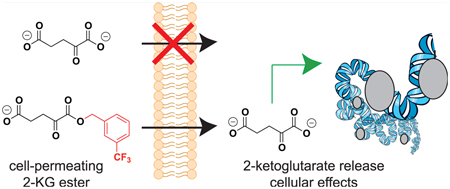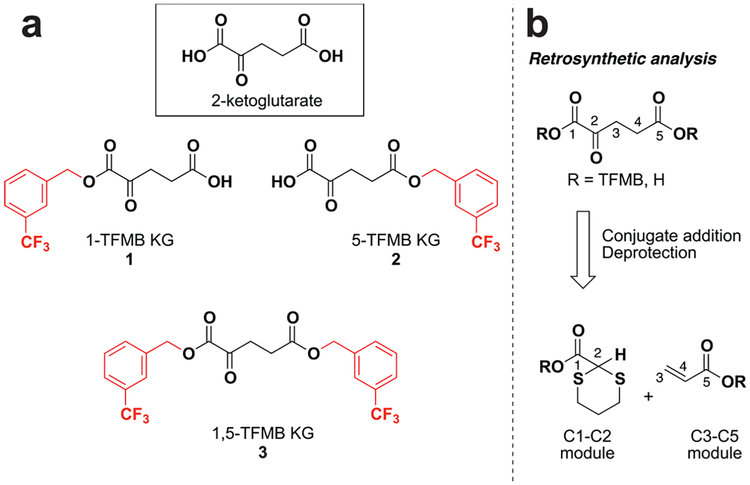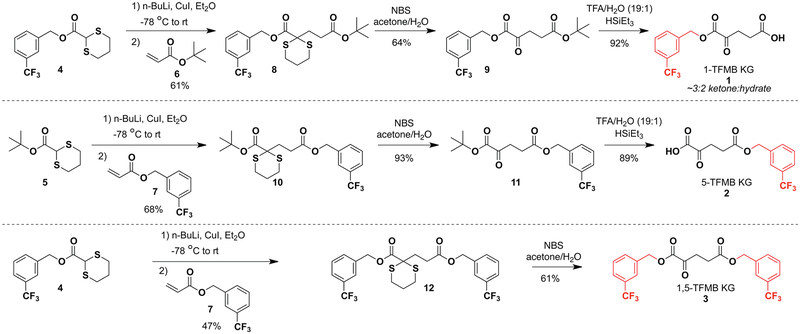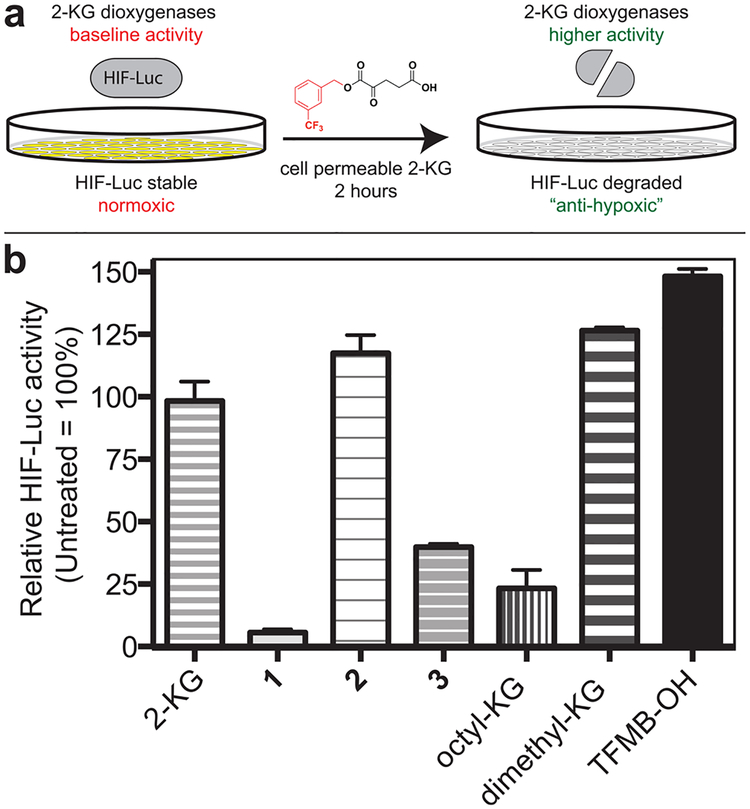Abstract
Cell-permeating esters of 2-ketoglutarate (2-KG) have been synthesized through a convergent sequence from two modules in two and three steps, respectively. This route provides access to a full series of mono- and disubstituted 2-KG esters, enabling us to define the effect of regioisomeric masking on metabolite release and antihypoxic activity in cell-based assays. In addition to providing insight into the biological activity of cell permeable 2-KG esters, the straightforward and modular nature of this synthetic route may prove useful for the development of next-generation 2-KG analogues for diagnostic and therapeutic applications.
Graphical Abstract

2-Ketoglutarate (2-KG) plays a central role in cellular homeostasis, functioning both as a metabolic intermediate and a cofactor for Fe(II)-dependent dioxygenase enzymes.1 Disruption of the cofactor function of 2-KG can have drastic phenotypic effects, as illustrated in cancers driven by succinate dehydrogenase (SDH),2,3 fumarate hydratase (FH),4 and isocitrate dehydrogenase (IDH) mutations.5,6 These mutations lead to the cellular accumulation of “oncometabolites” that compete with 2-KG for dioxygenase active sites. For example, inhibition of 2-KG dependent prolyl hydroxylases by fumarate increases the stability of HIF-1α, a transcription factor involved in tumor angiogenesis and malignant transformation.7 Chemical methods capable of restoring 2-KG cofactor activity in living cells thus represent a valuable goal.
A straightforward approach to reactivate 2-KG utilizing enzymes in oncometabolite-driven cancers would be to pharmacologically raise the intracellular 2-KG concentration, thereby alleviating competitive inhibition. However, 2-KG is a dicarboxylate and, thus, sparingly cell permeable. The permeability of 2-KG can be increased by masking its negatively charged carboxylate groups with hydrolytically labile esters. Gottlieb and co-workers demonstrated that 1-[3-trifluomethylbenzyl]-KG (1, Figure 1a) could be used to specifically increase 2-KG levels and stimulate the dioxygenase-mediated degradation of HIF-1α in hypoxic cancer cells.8,9 Structurally distinct 2-KG esters have also been demonstrated to extend the lifespan in C. elegans (1-octyl-KG),10 aid in the maintenance of stem cell pluripotency (1,5-dimethyl-KG),11 and inhibit autophagy (1,5-dimethyl-KG).12 More recently, 2-KG esters have been proposed as sensitive probes for diagnostic detection of oncometabolites using hyperpolarized 13C-imaging.13,14
Figure 1.
(a) 2-Ketoglutarate and cell-permeable 2-KG esters. (b) Retrosynthetic analysis of 2-KG esters.
Although such studies speak to the potential utility of 2-KG esters in biology and medicine, these applications are limited by their difficult synthesis. 2-KG itself presents a surprisingly challenging target for synthetic manipulation owing to its small size, high polarity, and susceptibility to enolization and nucleophilic attack. Initial studies of bioactive 2-KG esters such as 1 reported their preparation via regiospecific esterification of 2-KG at the 1-position.8 However, in our hands, as well as those of others,15 attempts to directly monoesterify 2-KG are low yielding and result in a complex mixture of products. Synthetic tractability is one reason limited structure–function data for 2-KG esters exists. For example, the biological studies referenced above used a wide variety of 2-KG esters whose relative potencies have not been established.9–11 Critically, the effect of regioisomeric masking on metabolite release and biological activity has not been defined for any 2-KG ester.16
With these considerations in mind, we sought to develop a concise synthetic route to regioisomerically pure 2-KG esters. We focused on a modular synthesis capable of accessing both asymmetric 2-KG monoesters. Such an approach would enable us to define how ester regiochemistry impacts the antihypoxic activity of 2-KG analogues and also potentially facilitate future imaging applications requiring 13C-labeled 2-KG esters. While modular syntheses have been invaluable for programming new functions into cofactors such as SAM17 and acetyl-CoA,18 they have not been widely applied to 2-KG esters to date.15 This led us to pursue a concise route to 2-KG esters that was modular, convergent, and utilized readily accessible synthetic building blocks (Figure 1, 1–3). Our approach separated 2-KG into two straightforward synthetic modules: the α-keto acid (C1–C2) and propionic acid (C3–C5) (Figure 1). The utility of 1,3-dithianes as acyl anion equivalents has been established in many contexts, including for the synthesis of α-keto acids.19 Nevertheless, this approach had not previously been applied for the synthesis of 2-KG analogues. The propensity of β-halo esters to eliminate when treated with lithiated dithiane anions19 led us to focus on a conjugate addition approach employing an acrylate ester as the cognate electrophile. Notably, precedent for this convergent strategy was furnished by Baldwin and coworkers, who explored a related approach in their synthesis of isotopically labeled, but not esterified, 2-KG.20 For the structure of the masking ester, we focused on the aforementioned 3-(trifluoromethyl)benzyl (TFMB) alcohols, which have been shown to facilitate the delivery of 2-KG and related dicarboxylate metabolites.21,22
Accordingly, protected 1,3-dithiane carboxylates 4 and 5 were treated with n-butyllithium, converted to the cuprates in situ using CuI, and added to acrylate esters 6 and 7 (Scheme 1).23 This furnished the orthogonally protected 1,3-dithiane conjugates in moderate yields (47–68%). tert-Butyl acrylate 6 gave slightly higher yields upon Michael addition with the 4-derived cuprate than TFMB-acrylate 7. Efforts to utilize unprotected acrylic acid as an electrophile in the addition reaction were unsuccessful. While dithiane removal can sometimes prove problematic, deprotection proceeded smoothly when applied to KG analogues using freshly recrystallized NBS, although lower yields were observed for 1-TFMB KG precursors 8 and 12. Final removal of the tert-butyl esters with TFA provided TFMB KG esters 1–3 in reasonable yields (30–55% from starting materials). This approach provided facile access to a complete panel of TFMB esters and represents a significant improvement over previous methods.20 Interestingly, while 2 and 3 were readily isolable exclusively in ketone form, we observed that the hydrate of 1 formed regardless of workup conditions (Supporting Information). This correlates with the enhanced carbonyl electro-philicity of the α-keto ester of 1, which may increase its susceptibility to acid-catalyzed hydration.
Scheme 1.
Synthesis of Regiospecifically Protected KG Esters 1−3
Having established a modular synthetic route to 2-KG esters, we next sought to apply the derived molecules to generate directly comparable structure–activity data for this compound class. 2-KG esters including 1 have been shown to decrease cellular levels of the transcription factor HIF-1α under hypoxic, pseudohypoxic, and normoxic conditions.7,9,24 To gain an initial measure of the relative activity of these compounds, we tested their effects in a HeLa cell line that stably expresses a HIF-1α-luciferase (HIF-Luc) gene fusion.25 In this model, stimuli that trigger HIF-1α degradation result in decreased cellular luminescence upon luciferase treatment (Figure 2). Importantly, this assay does not conclusively demonstrate 2-KG delivery and dioxygenase activation but rather provides a straightforward, preliminary measure of 2-KG ester biological activity.24 In HIF-Luc cells grown under normoxic (21% O2) conditions and treated with 1 mM of each compound, 2-KG ester 1 strongly inhibited luciferase activity (>90% decrease in HIF-Luc relative to untreated control; Figure 2), consistent with its reported ability to trigger HIF-1α degradation.7 Notably, this reduced luciferase activity was not a consequence of cell death, as cells were analyzed at short time points (2 h) under which there was no evidence of cytotoxicity. Diester 3 was slightly less active (>50% decrease in HIF-Luc), while regioisomeric monoester 2 had no measurable effect on HIFLuc levels (Figure 2). While the ability of 1 to reduce HIF-1α protein levels has been previously reported,8,9 we validated the effects of novel diester 3 on HIF-1α levels via Western blot (Figure S1, Supporting Information). Interestingly, we found that at concentrations below 1 mM, 1 and 3 cause a paradoxical increase in HIF-Luc luminescence (Figure S2, Supporting Information). The ability of 3 to increase HIF protein levels at lower doses was also verified by Western blot (Figure S1, Supporting Information). Finally, we analyzed two commercial 2-KG esters, 1-octyl-KG and 1,5-dimethyl-KG, that have been applied in a number of studies.10,11,26 1-Octyl-KG reduced HIF-Luc levels, although less potently than 1, while 1,5-dimethyl-KG did not cause measurable HIF-Luc degradation at 1 mM.
Figure 2.
(a) Schematic for cell-based assay of antihypoxic effects of 2-KG esters. A cell line stably expressing a HIF-luciferase gene fusion is treated with cell permeable 2-KG esters. Literature precedent suggests delivery of 2-KG can increase the activity of 2-KG dependent dioxygenases, including PHD2, the prolyl hydroxylase responsible for HIF degradation. (b) Quantitative analysis of cellular antihypoxic activity of 2-KG esters (1 mM). All values are normalized to the average HIF-Luciferase activity of untreated control cells (set at 100%). Compounds 1 and 3 reduce HIF-Luc luciferase activity, consistent with 2-KG release and dioxygenase activation. Values represent the average of three biological replicates, ± standard deviation.
The differential activity of 1 and 2 in the HIF-Luc assay may reflect alterations in kinetics of KG release caused by ester regiochemistry. Therefore, we measured the aqueous stability of these compounds (Table 1). Applying a coupled-enzyme assay to detect ketoglutarate release, we found 1-TFMB ester 1 was considerably more labile than regioisomeric 5-TFMB ester 2 (62% hydrolyzed versus 18% hydrolyzed over 2 h). This is consistent with the greater acidity and leaving group potential of the 1-carboxylate (pKa ~2.5) versus the 5-carboxylate (pKa ~4.6) of ketoglutarate.27 While these analyses admittedly represent a simplification of cellular conditions (where esterases may also contribute to KG release) they suggest a direct correlation between the HIF-destabilizing activity of 2-KG esters and their inherent nonenzymatic hydrolytic lability. Interestingly diester 3, which also contains a slow-hydrolyzing 5-TFMB ester, demonstrates greater antihypoxic activity than 2. This suggests that enhanced uptake of highly lipophilic 2-KG diesters can result in biologically meaningful 2-KG release, despite slow hydrolysis at the C5 position.
Table 1.
Aqueous Stability of 2-KG Esters (PBS pH 7.2)
| compd | ester regiochemistry | % hydrolysis |
|---|---|---|
| 1 | C1-TFMB | 61.5 ± 2.2 |
| 2 | C5-TFMB | 18.0 ± 1.9 |
In conclusion, here we have reported a modular synthesis of cell-permeating 2-KG esters. This approach provides facile access to pure 2-KG ester regioisomers, and enabled a direct comparison of their biological activity in a cell-based luciferase assay. We found 1-TFMB KG 1 (3:2 ratio of ketone/hydrate) and 1-octyl-KG efficiently trigger the degradation of HIF-1α-luciferase, highlighting the potential utility of C1-substituted 2-KG esters as antihypoxic agents. We note that while 2-KG esters, including 1, have been shown to directly increase 2-KG levels as well as HIF-hydroxylation in cells, our luciferase assay does not conclusively demonstrate either phenomenon. However, our findings are consistent with literature showing cell-permeable 2-KG esters can trigger HIF-degradation even under normoxic conditions24 (similar to the degradation of normoxic HIF-1α that can be induced by addition of exogenous iron or ascorbate to cells28,29) and provide a foundation for further study. An unexpected finding of this analysis was that low concentrations of 1 and 3 cause stabilize of HIF-1α, a phenomenon verified both by luciferase assay and Western blot (Figure S1, Supporting Information). While the mechanistic basis for this effect is beyond the focus of our studies reported here, we did find that TFMB alcohol (the hydrolysis byproduct of 2-KG esters 1–3) itself is capable of inducing HIF-Luc stabilization in our luciferase-based assay (Figure S3, Supporting Information). In addition, stable esters of 2-KG and 2-KG isosteres have recently been shown to directly inhibit hydroxylases.24,30 The paradoxical activity of 2-KG esters at low concentrations may explain why initial studies of TFMB-KG 1 required repeated, high-concentration dosing to achieve antihypoxic effects (for example, 1 mM KG-ester 1 added to cells every 3 h for 9 h).8,9 These findings also suggest 2-KG esters whose cleavage byproducts do not stabilize HIF-Luc may have improved antihypoxic properties. Such examples also highlight the balance that must be maintained in pro-drug strategies between enhanced delivery of the compound of interest (i.e., 2-KG) and the ancillary biological activity of the pro-drug/byproducts (i.e., TFMB alcohol).31 These considerations are of paramount importance in masking strategies designed to deliver cellular metabolites such as 2-KG, which are routinely applied at the millimolar concentrations in biological studies. Finally, the modular nature of this synthesis should be amenable to the preparation of 13C-enriched 2-KG esters. Notably, the synthesis isotopically labeled C1 and C2 2-KG synthons has been previously reported20 and should be directly integrable with our route. Current efforts are focused on applying this approach toward the synthesis of diverse [13C]-2-KG esters with improved uptake and hyperpolarization properties, for utilization as diagnostic reporters of cancer metabolism. These studies will be reported in due course.
Supplementary Material
ACKNOWLEDGMENTS
We thank Prof. Tsui-Fen Chou (UCLA) for ODD-Luc HeLa cells, Dr. W. Marston Linehan (NCI) for the kind gift of a 2-KG detection kit, and Dr. Martin Schnermann (NCI) for many helpful discussions. This work was supported by the Intramural Research Program of the NIH, National Cancer Institute, Center for Cancer Research (ZIA BC011488–02).
Footnotes
Supporting Information
Experimental procedures, compound characterization data, and supporting figures. This material is available free of charge via the Internet at http://pubs.acs.org.
The authors declare no competing financial interest.
REFERENCES
- (1).Locasale JW; Cantley LC Cell Metab 2011, 14, 443–451. [DOI] [PMC free article] [PubMed] [Google Scholar]
- (2).Baysal BE; Ferrell RE; Willett-Brozick JE; Lawrence EC; Myssiorek D; Bosch A; van der Mey A; Taschner PE; Rubinstein WS; Myers EN; Richard CW III; Cornelisse CJ; Devilee P; Devlin B Science 2000, 287, 848–851. [DOI] [PubMed] [Google Scholar]
- (3).Hao HX; Khalimonchuk O; Schraders M; Dephoure N; Bayley JP; Kunst H; Devilee P; Cremers CW; Schiffman JD; Bentz BG; Gygi SP; Winge DR; Kremer H; Rutter J Science 2009, 325, 1139–1142. [DOI] [PMC free article] [PubMed] [Google Scholar]
- (4).Tomlinson IP; Alam NA; Rowan AJ; Barclay E; Jaeger EE; Kelsell D; Leigh I; Gorman P; Lamlum H; Rahman S; Roylance RR; Olpin S; Bevan S; Barker K; Hearle N; Houlston RS; Kiuru M; Lehtonen R; Karhu A; Vilkki S; Laiho P; Eklund C; Vierimaa O; Aittomaki K; Hietala M; Sistonen P; Paetau A; Salovaara R; Herva R; Launonen V; Aaltonen LA Nat. Genet 2002, 30, 406–410. [DOI] [PubMed] [Google Scholar]
- (5).Yan H; Parsons DW; Jin G; McLendon R; Rasheed BA; Yuan W; Kos I; Batinic-Haberle I; Jones S; Riggins GJ; Friedman H; Friedman A; Reardon D; Herndon J; Kinzler KW; Velculescu VE; Vogelstein B; Bigner DD N. Engl. J. Med 2009, 360, 765–773. [DOI] [PMC free article] [PubMed] [Google Scholar]
- (6).Marcucci G; Maharry K; Wu YZ; Radmacher MD; Mrozek K; Margeson D; Holland KB; Whitman SP; Becker H; Schwind S; Metzeler KH; Powell BL; Carter TH; Kolitz JE; Wetzler M; Carroll AJ; Baer MR; Caligiuri MA; Larson RA; Bloomfield CD J. Clin. Oncol 2010, 28, 2348–2355. [DOI] [PMC free article] [PubMed] [Google Scholar]
- (7).Isaacs JS; Jung YJ; Mole DR; Lee S; Torres-Cabala C; Chung YL; Merino M; Trepel J; Zbar B; Toro J; Ratcliffe PJ; Linehan WM; Neckers L Cancer Cell 2005, 8, 143–153. [DOI] [PubMed] [Google Scholar]
- (8).MacKenzie ED; Selak MA; Tennant DA; Payne LJ; Crosby S; Frederiksen CM; Watson DG; Gottlieb E Mol. Cell. Biol 2007, 27, 3282–3289. [DOI] [PMC free article] [PubMed] [Google Scholar]
- (9).Tennant DA; Frezza C; MacKenzie ED; Nguyen QD; Zheng L; Selak MA; Roberts DL; Dive C; Watson DG; Aboagye EO; Gottlieb E Oncogene 2009, 28, 4009–4021. [DOI] [PubMed] [Google Scholar]
- (10).Chin RM; Fu X; Pai MY; Vergnes L; Hwang H; Deng G; Diep S; Lomenick B; Meli VS; Monsalve GC; Hu E; Whelan SA; Wang JX; Jung G; Solis GM; Fazlollahi F; Kaweeteerawat C; Quach A; Nili M; Krall AS; Godwin HA; Chang HR; Faull KF; Guo F; Jiang M; Trauger SA; Saghatelian A; Braas D; Christofk HR; Clarke CF; Teitell MA; Petrascheck M; Reue K; Jung ME; Frand AR; Huang J Nature 2014, 510, 397–401. [DOI] [PMC free article] [PubMed] [Google Scholar]
- (11).Carey BW; Finley LW; Cross JR; Allis CD; Thompson CB Nature 2015, 518, 413–416. [DOI] [PMC free article] [PubMed] [Google Scholar]
- (12).Marino G; Pietrocola F; Kong Y; Eisenberg T; Hill JA; Madeo F; Kroemer G Autophagy 2014, 10, 930–932. [DOI] [PMC free article] [PubMed] [Google Scholar]
- (13).Lerche MH; Jensen PR; Karlsson M; Meier S Anal. Chem 2015, 87, 119–132. [DOI] [PubMed] [Google Scholar]
- (14).Chaumeil MM; Larson PE; Yoshihara HA; Danforth OM; Vigneron DB; Nelson SJ; Pieper RO; Phillips JJ; Ronen SM Nat. Commun 2013, 4, 2429. [DOI] [PMC free article] [PubMed] [Google Scholar]
- (15).Jung ME; Deng GJ Org. Chem 2012, 77, 11002–11005. [DOI] [PMC free article] [PubMed] [Google Scholar]
- (16).Aich U; Campbell CT; Elmouelhi N; Weier CA; Sampathkumar SG; Choi SS; Yarema KJ ACS Chem. Biol 2008, 3, 230–240. [DOI] [PubMed] [Google Scholar]
- (17).Bothwell IR; Luo M Org. Lett 2014, 16, 3056–3059. [DOI] [PMC free article] [PubMed] [Google Scholar]
- (18).Mandel AL; La Clair JJ; Burkart MD Org. Lett 2004, 6, 4801–4803. [DOI] [PubMed] [Google Scholar]
- (19).J CE; D S. Angew. Chem., Int. Ed 1965, 4, 1075–1077. [Google Scholar]
- (20).Baldwin JE; Adlington RM; Russell MA; Schofield CJ; Wood ME J. Labelled Compd Radiopharm 1989, 27, 1091–1099. [Google Scholar]
- (21).Kaadige MR; Looper RE; Kamalanaadhan S; Ayer DE Proc. Natl. Acad. Sci. U.S.A 2009, 106, 14878–14883. [DOI] [PMC free article] [PubMed] [Google Scholar]
- (22).Losman JA; Looper RE; Koivunen P; Lee S; Schneider RK; McMahon C; Cowley GS; Root DE; Ebert BL; Kaelin WG Jr. Science 2013, 339, 1621–1625. [DOI] [PMC free article] [PubMed] [Google Scholar]
- (23).Adams LA; Valente MWN; Williams RM Tetrahedron 2006, 62, 5195–5200. [Google Scholar]
- (24).Hou P; Kuo CY; Cheng CT; Liou JP; Ann DK; Chen Q PLoS One 2014, 9, e113865. [DOI] [PMC free article] [PubMed] [Google Scholar]
- (25).Chou TF; Deshaies RJ J. Biol. Chem 2011, 286, 16546–16554. [DOI] [PMC free article] [PubMed] [Google Scholar]
- (26).Weinberg F; Hamanaka R; Wheaton WW; Weinberg S; Joseph J; Lopez M; Kalyanaraman B; Mutlu GM; Budinger GR; Chandel NS Proc. Natl. Acad. Sci. U.S.A 2010, 107, 8788–8793. [DOI] [PMC free article] [PubMed] [Google Scholar]
- (27).Kerber RC; Fernando MS J. Chem. Educ 2010, 87, 1079–1084. [Google Scholar]
- (28).Knowles HJ; Raval RR; Harris AL; Ratcliffe PJ Cancer Res 2003, 63, 1764–1768. [PubMed] [Google Scholar]
- (29).Knowles HJ; Mole DR; Ratcliffe PJ; Harris AL Cancer Res 2006, 66, 2600–2607. [DOI] [PubMed] [Google Scholar]
- (30).Schiller R; Scozzafava G; Tumber A; Wickens JR; Bush JT; Rai G; Lejeune C; Choi H; Yeh TL; Chan MC; Mott BT; McCullagh JS; Maloney DJ; Schofield CJ; Kawamura A ChemMedChem 2014, 9, 566–571. [DOI] [PMC free article] [PubMed] [Google Scholar]
- (31).Lavis LD ACS Chem. Biol 2008, 3, 203–206. [DOI] [PubMed] [Google Scholar]
Associated Data
This section collects any data citations, data availability statements, or supplementary materials included in this article.





